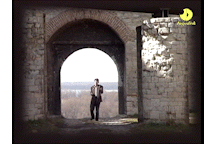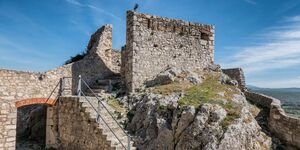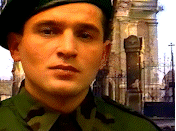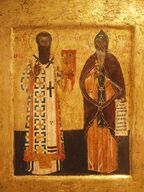Ne dam Krajine (Song)
| "Не дам Крајине" | |
|---|---|
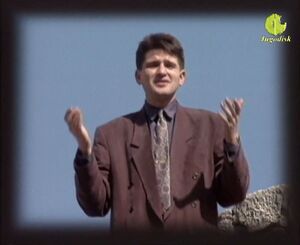 Still from version 1 of the official music video. | |
| Song by Баја Мали Книнџа | |
| from the album Не дам Крајине | |
| English title | I Won't Give Krajina |
| Released | 1991 |
| Genre | Novokompovana |
| Length | 3:10 |
| Label | Jugodisk |
| Producer(s) | Жељко Грујић |
"Ne dam Krajine" (Serbian Cyrillic: "Не дам Крајине", lit. "I Don't Give Krajina") is a song written and performed by prominent Serb war singer Baja Mali Knindža. Upon the release of Ne dam Krajine, the song would become a hit and received two music videos. The song would be covered in the 1993 Bora Drljača album, Nedam Krajine. It would also be featured as a bonus track in the 2020 digital release of Stan'te paše i ustaše, though was removed in a re-release published in the same year.
Music and lyrics
This song would be the first to mention Baja's cousin Lazo, his brother Novak, and his friend Jovo Kalaba. It is also the first of many songs that mention the villages Gubin, Sajković, and Provo. It is one of few songs in Baja's discography that mentions the village of Kazanci.
Like some war songs written in this era, there's a mention of the use of Cyrillic and a crossing with three fingers as notable cultural practices with Serbs.
While not uncommon in Baja's work, when he sings the lyrics "Učio sam ćirilicu", you can hear him smiling.
Music Video
Music video 1 (Jugodisk)
This version is fairly basic with Baja either singing or wondering around Knin Castle with occasional close-up shots. When Baja sings "S' tri se prsta krstim/Moja desna ruka", he proudly displays the three fingers.
This music video has Baja wearing the same attire seen in the "Božić je" and "Kad sam bio mali" videos. It was originally uploaded to the Jugodisk YouTube channel in 2015 with the video being saturated and the audio quality being poor and predominantly in the right channel.[1] It was upscaled with high quality audio in 2020,[2] though both 2015 and 2020 versions do not provide any sort of context as to where the video originated from. It is speculated that it is either from a Jugodisk VHS compilation or was originally made for Najveći hitovi, but was scrapped in favor of the second version.
Music video 2 (SuperTon)
This version would appear as the final song in the 1993 compilation Najveći hitovi. It would have higher production value complete with costumes, actors, and a makeshift set. It would also include digital editing such as superimposing via a green screen, image editing, and screen transitions. This version would be the first to surface on the internet and would be the most known version of the video.
The music video opens up with a boy tagging the wall with "СРБИјА". It then cuts to Baja, armed with a rifle, singing around a campfire with someone smoking in the background. After singing the chorus, a shot of a boy waving a flag is shown and transitions to footage of a church, followed by footage of someone driving by a destroyed church. The boy is superimposed on the footage and an image of Kninja commander Dragan Vasiljković is shown. The scene then transitions to Baja, now facing away from the camera this time standing with a backpack with a radio antenna sticking out. A close-up shot is then layered on the scene, subsequently transitions to Baja back at the campfire for the chorus, followed by the close up shot. Footage of a destroyed town is shown, followed by the boy waving the flag slowed down and panning out. The scene transitions to a still of a church with Baja being superimposed and placed to the left, now facing the camera. An image of one of the oldest depictions of St. Sava and St. Simeon is briefly displayed to the right, rotate and disappear. When Baja repeats the lines "Učio sam ćirilicu/Karadžića Vuka", the scene cuts back to the campfire. Upon the last time the chorus is repeated, Baja is superimposed on footage of a flag waving, slowed down. The scene pans inward past Baja and when the song ends, the video ends with a paused still of the flag for a few seconds until the screen fades to yellow, then to blue where the credits subsequently roll.
Baja wears M93 camo (one of the most common camouflage patterns the JNA used during the war) and a standard olive beret with a Kninja patch that is either the standard version or a special tri-color variant depending on the scene. The man seen smoking around the campfire with Baja has a black jumpsuit with a red beret, reminiscent of the uniforms Arkan's Tigers wore. The child (who is also seen in the music video of "Kad sam bio mali") wears DPM camo instead of the VRS lizard camo pattern and waves a flag. Despite its use bring frequent in this time period, flag used is an alleged unofficial flag design.[3]
Lyrics
Lyrics:Odakle si brale? |
Lyrics (English):Where are you from, brother? |
References
- ↑ Baja Mali Knindza - Ne dam Krajine - (Official Video 1993). Jugodisk Beograd. 25 November 2015. Retireved 28 November 2023.
- ↑ Baja Mali Knindza - Ne dam Krajine - (Official video 1991)HD. Jugodisk Beograd. 17 November 2023. Retrieved 28 November 2023.
- ↑ Serbia (Serbia and Montenegro), 1992-2004. Five Star Flags. 19 August 2006. Retrieved 25 November 2023.
